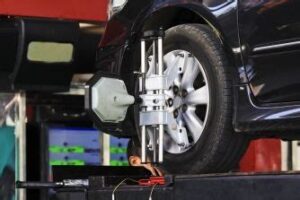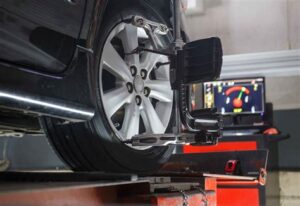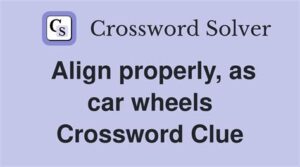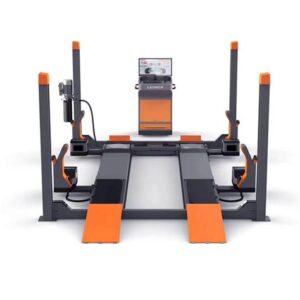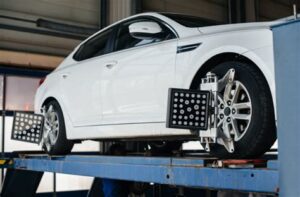Are you a car enthusiast who has taken the plunge into the world of lowered vehicles? If so, understanding the intricacies of wheel alignment is crucial to maintaining your ride’s performance and safety. Wheel alignment for lowered cars can be a complex process, influenced by various factors including the size of your vehicle’s modifications. Proper alignment is essential not only for optimal driving experience but also for prolonging the lifespan of your tires and suspension components. In this article, we delve into the specifics of wheel alignment for lowered cars, exploring how lowering affects alignment settings, the essential tools needed for the job, and the benefits that come from maintaining proper alignment. Moreover, we will highlight the common issues associated with incorrect wheel alignment, ensuring your lowered car runs smoothly and safely on the road. Let’s get started!
Understanding Wheel Alignment For Lowered Cars
Wheel alignment refers to the adjustment of a vehicle’s suspension system to ensure that all four wheels are positioned correctly relative to each other and to the road. For lowered cars, the dynamics of suspension geometry change significantly. When lowering a car, the angles of the wheels can be altered, which often leads to misalignment.
In cars with modified suspensions, such as those that have been lowered, achieving proper wheel alignment becomes even more crucial. This is because lowered vehicles can experience changes in camber, caster, and toe angles. Proper adjustment of these angles not only enhances the vehicle’s handling but also extends the life of tires and other components.
Lowering a car often results in a more aggressive stance, improving aesthetics and handling but at the expense of factory alignment settings. Therefore, it is essential to understand how to properly realign the vehicle after modifications have been made.
Generally, there are three primary angles that are adjusted during a wheel alignment:
- Camber: The angle of the wheels in relation to the vertical axis. It can affect tire wear and cornering stability.
- Caster: The angle of the steering pivot point, which influences steering feel and stability.
- Toe: The angle at which the tires point in relation to the centerline of the vehicle, impacting tire wear and directional control.
When lowering a vehicle, the best practice is to have a professional alignment service assess the alignment settings post-modification to ensure optimal performance. Doing so prevents uneven tire wear and promotes safety while driving.
How Lowering Affects Wheel Alignment Settings
When a car is lowered, it significantly alters its suspension geometry and affects the wheel alignment settings. This adjustment can lead to changes in the camber, toe, and caster angles, which are critical for proper handling, tire wear, and overall vehicle stability.
1. Camber: This is the angle of the wheel in relation to the road surface when viewed from the front of the car. Lowering a car typically increases negative camber, meaning the top of the wheels tilts inward. While this can improve handling in cornering, excessive negative camber can lead to uneven tire wear.
2. Toe: This refers to the angle of the wheels when viewed from above. Proper toe alignment helps ensure straight traction and stability when driving. Lowering a car can cause toe settings to shift, often requiring correction to avoid increased tire wear and poor handling.
3. Caster: Although less affected by lowering than camber and toe, caster angle can still be influenced by the reduced ride height. A positive caster angle improves steering stability but may need adjustment to optimize handling characteristics.
The table below summarizes the typical effects of lowering a car on wheel alignment settings:
| Alignment Angle | Effect of Lowering | Potential Outcome |
|---|---|---|
| Camber | Increased negative camber | Improved cornering but uneven tire wear |
| Toe | Misalignment likely | Poor handling and tire wear |
| Caster | Possible changes | Requires adjustment for optimal steering |
To ensure optimal performance and longevity of tires, it’s critical for owners of lowered cars to regularly check and adjust their wheel alignment settings following any modifications. Proper tuning can result in enhanced handling characteristics and a smoother driving experience.
Essential Tools For Achieving Perfect Wheel Alignment
Achieving the right wheel alignment for lowered cars requires the right set of tools. Below are some essential tools that can help you ensure optimal alignment settings:
- Alignment Machine: A state-of-the-art alignment machine is crucial for measuring angles accurately. It provides precise data on camber, caster, and toe adjustments.
- Toe Plates: These are simple and effective tools that help measure toe angles directly, especially if a full alignment machine is not available.
- Camber Gauge: This tool allows you to measure the camber angle effectively, ensuring that your wheels are positioned correctly for handling and tire wear.
- Torque Wrench: Using a calibrated torque wrench ensures that all suspension components are tightened to manufacturer specifications, preventing any adjustments made from coming loose.
- Alignment Specifications Sheet: Always refer to a detailed specifications sheet for your specific vehicle model to ensure you adjust your settings according to manufacturer guidelines.
A combination of these tools will help you achieve the perfect wheel alignment for your lowered car, enhancing performance and prolonging tire life. Regular checks using these tools can make a significant difference in how your vehicle handles on the road.
Benefits Of Proper Wheel Alignment For Lowered Cars
Ensuring proper wheel alignment for lowered cars is crucial for a variety of reasons. When a vehicle is lowered, its suspension geometry changes, which can significantly impact the alignment settings. Here are some key benefits of maintaining correct wheel alignment in lowered vehicles:
- Improved Handling: A well-aligned suspension system enhances the handling characteristics of lowered cars. This means drivers can enjoy better control during turns and improved responsiveness to steering inputs.
- Enhanced Tire Life: Proper wheel alignment minimizes tire wear by ensuring even contact between the tires and the road surface. This results in longer-lasting tires, saving you money in the long run.
- Increased Safety: Maintaining correct alignment helps prevent unexpected handling issues that could lead to accidents. Safe driving is particularly important for lowered cars, which often have less ground clearance.
- Optimized Performance: For performance-oriented lowered cars, achieving the right wheel alignment can maximize grip and stability, which translates into better acceleration, braking, and overall performance.
- Improved Ride Comfort:Incorrectly aligned suspension components can lead to a harsh ride. Proper wheel alignment helps ensure a smoother driving experience, making day-to-day commutes more enjoyable.
Maintaining proper wheel alignment for lowered cars is essential not only for aesthetics but also for performance, safety, and cost efficiency. Regular checks and adjustments can lead to a more satisfying driving experience.
Common Issues From Incorrect Wheel Alignment In Lowered Cars
When it comes to wheel alignment in lowered cars, improper adjustments can lead to a variety of complications that affect both performance and safety. Here are some common issues that may arise:
- Tire Wear: One of the most noticeable consequences of incorrect wheel alignment is uneven tire wear. Lowered vehicles may experience excessive wear on the inner or outer edges of the tires, leading to premature replacements.
- Steering Problems: A misaligned wheel can cause your steering to feel loose or unresponsive. This results in difficulty maintaining straight-line stability, which can be dangerous on the road.
- Alignment Drift: Lowered cars may face alignment drift where the steering wheel does not return to the center after a turn. This issue can make driving more challenging and less safe.
- Increased Road Noise: Poor alignment can lead to vibrations and increased road noise, making for a less comfortable ride and a potentially unsafe driving experience.
- Suspension Strain: Incorrect wheel alignment can put additional strain on suspension components, leading to faster wear and costly repairs in the long run.
To avoid these issues, it is crucial to ensure that your car’s wheel alignment is correctly calibrated, especially after any suspension modifications. Regular checks and adjustments will keep your car performing at its best.
Frequently Asked Questions
What is wheel alignment and why is it important?
Wheel alignment refers to the adjustment of the angles of the wheels so that they are set to the car manufacturer’s specifications. It is important for ensuring proper handling, tire wear, and overall vehicle safety.
How does lowering a car affect wheel alignment?
Lowering a car can drastically affect its wheel alignment because it changes the suspension geometry, which can lead to misalignment. This can cause premature tire wear and affect the car’s handling characteristics.
What symptoms indicate that my lowered car needs a wheel alignment?
Common symptoms include uneven tire wear, the car pulling to one side, a steering wheel that is off-center, and vibrations while driving.
Can I do a wheel alignment at home for my lowered car?
While some basic alignment checks can be done at home with the right tools, it’s strongly recommended to have a professional alignment done, especially for lowered cars, to ensure precision and accuracy.
How often should I get my lowered car’s wheel alignment checked?
It’s advisable to have your wheel alignment checked at least once a year or whenever you lower your car, replace suspension parts, or notice any related symptoms.
What are the potential consequences of neglecting wheel alignment on a lowered car?
Neglecting wheel alignment can lead to increased tire wear, reduced handling performance, decreased fuel efficiency, and potentially hazardous driving conditions.
Are there special considerations for aligning the wheels of a lowered car?
Yes, lowered cars may require specific alignment settings to accommodate their modified suspension and intended driving dynamics. Professional aligners can provide these specialized settings to optimize performance.
